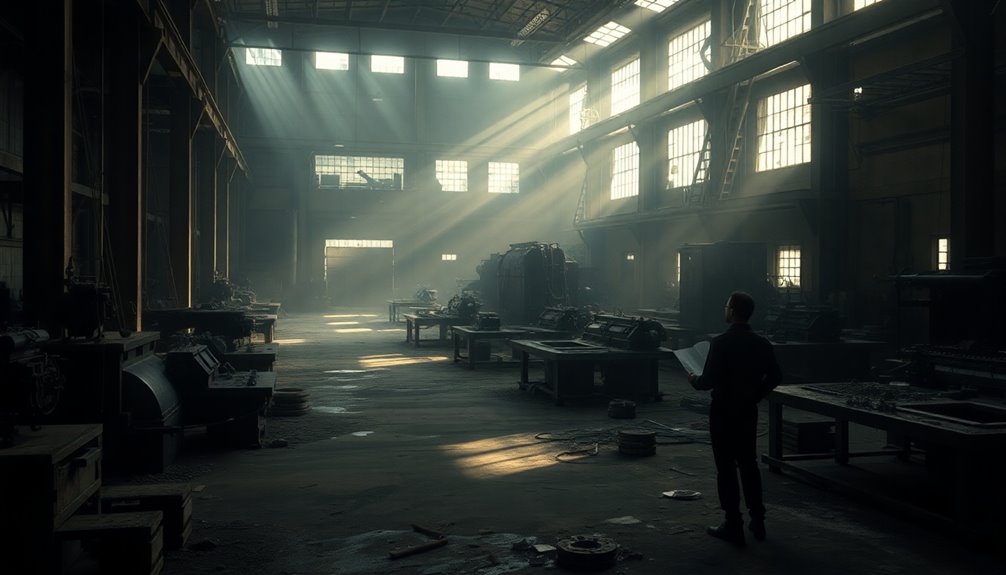Foundry's recent overhaul is a bold move aimed at survival in the tough cryptocurrency market. With a 27% workforce cut, the company is redirecting focus to enhance its Bitcoin mining operations, which currently dominate 30% of the total network hashrate. This restructuring includes launching new ventures like Yuma, an AI startup, while converting to a paid service model for mining pool fees. Despite challenges from its parent company, DCG, and market turbulence, Foundry's proactive changes might just spark a turnaround. To grasp the full impact of these strategies, there's more to explore.
Key Takeaways
- Foundry's 27% workforce reduction focuses on streamlining operations to enhance financial stability amid market changes and challenges.
- The strategic shift prioritizes Bitcoin mining pool operations, which currently represent 30% of the total network hashrate.
- Transitioning to a paid service model for mining pool fees is expected to significantly increase revenue, targeting $80 million by 2024.
- The launch of Yuma, an AI startup, signifies Foundry's commitment to innovation and adaptation in a turbulent cryptocurrency market.
- Ongoing financial challenges from Genesis's bankruptcy and legal issues emphasize the need for effective cost management and operational efficiency.
Overview of Recent Layoffs

Foundry recently underwent significant layoffs as part of a restructuring effort aimed at streamlining operations and focusing on core business areas. The company reduced its headcount from 274 to 200 employees, marking a substantial 27% cut. This decision impacted around 16% of U.S. employees and affected various teams across the organization.
Rather than isolating specific departments, the layoffs spanned multiple business lines, demonstrating the sweeping nature of the changes.
While some employees faced dismissal, others were shifted to a new subsidiary, Yuma, a decentralized AI startup that emerged from Foundry's internal AI arm, Bittensor. Foundry management communicated these difficult decisions through individual notifications before a team meeting, emphasizing the necessity of these layoffs for the company's future. Foundry's Bitcoin mining pool accounts for approximately 30% of the total Bitcoin network hashrate, highlighting the significance of its core operations.
These reductions come amid broader restructuring efforts within the parent company, Digital Currency Group (DCG), which has been grappling with significant financial challenges, including the bankruptcy of its crypto lending subsidiary, Genesis.
Foundry's layoffs reflect the urgent need to realign its operations and stabilize within a turbulent market, marking a critical turning point for the company.
Strategic Business Line Changes

Amidst the restructuring efforts, the company's strategic focus has shifted towards its core business of operating the leading Bitcoin mining pool. Foundry's decision to strengthen its site operations comes as it deprioritizes custom hardware initiatives, leading to the dismissal of its ASIC repair and hardware teams. Resources are being reallocated to enhance revenue-generating operations, while non-core business lines are streamlined or eliminated. This realignment is essential as the company aims for an expected revenue of $80 million from self-mining by 2024.
Here's a breakdown of these strategic changes:
| Focus Area | Changes Made | Impact |
|---|---|---|
| Core Business | Strengthening Bitcoin mining pool operations | Enhanced market position |
| Custom Hardware | Deprioritized and teams dismissed | Reduced operational costs |
| Diversified Initiatives | Reassessing decentralized AI infrastructure | Potential for future growth |
| Resource Allocation | 20 staff transferred to Yuma, a DCG subsidiary | Focus on core revenue streams
Core Operations and Revenue Impact

The shift in core operations at Foundry has significant implications for its revenue streams and market positioning. By focusing on its Bitcoin mining pool, which accounts for 30% of the total network hashrate, you can expect enhanced revenues from this critical segment. The self-mining business is projected to generate $80 million in 2024, reinforcing its importance in the overall strategy.
Foundry's change to a paid service model for mining pool fees, previously offered at 0%, could also boost revenue, especially given its status as the leading Bitcoin mining pool globally. This adjustment aligns with the company's goal to improve operational efficiency while navigating challenging market conditions.
Site operations remain a key focus, driving significant income from managing large-scale mining sites. While custom hardware has been deprioritized, it isn't entirely off the table, allowing for potential revenue diversification.
The company's streamlined operations, including the maintenance of ASIC repair services, indicate a commitment to operational efficiency.
Additionally, Foundry's dedication to ESG-positive energy sources positions it favorably in an increasingly eco-conscious market.
Financial Context of Parent Company

You can see how the bankruptcy of Genesis has put significant pressure on DCG's financial stability. As the parent company, DCG's challenges directly affect Foundry's operations and growth potential. Understanding these financial hurdles is essential to grasp the broader implications for Foundry's future. The desire for independence from an overbearing parent organization could further influence Foundry's strategic decisions moving forward.
Genesis Bankruptcy Fallout
In the wake of Genesis' Chapter 11 bankruptcy filing in January 2023, significant financial repercussions have rippled through its parent company, Digital Currency Group (DCG).
Genesis owed over $3.5 billion to its top creditors, primarily due to its exposure to collapsed firms like Three Arrows Capital and FTX. The bankruptcy halted all trading operations, exacerbating financial strains. The fallout from the FTX collapse has further intensified the scrutiny surrounding DCG's financial practices.
The court approved a distribution of $3 billion in cash and cryptocurrencies to Genesis' creditors, covering about 77 percent of their claims. Creditors with USD claims will receive full repayment, while those with crypto claims face shortfalls.
Importantly, DCG, as an equity holder, won't recover any funds from this distribution.
Legal issues also loom large, with Genesis facing a $21 million fine for operating an illegal lending platform. New York Attorney General Letitia James secured a $2 billion settlement, establishing a victims' fund for affected investors.
DCG assumed $1.1 billion of Genesis's debt and engaged in multiple legal disputes, revealing anomalies in its financial practices.
The fallout from Genesis' bankruptcy is a stark reminder of the intertwined risks in the cryptocurrency sector.
DCG's Financial Challenges
Struggling under the weight of significant financial challenges, Digital Currency Group (DCG) has taken drastic measures to stabilize its operations. Despite a revenue increase in Q4 2023 to $210 million, the full-year earnings dipped to $749 million from $813 million the previous year. DCG's restructuring efforts have focused on debt repayment and cost-cutting to combat its $1.1 billion loss in 2022. Furthermore, the company has faced increased scrutiny from investors and stakeholders due to DCG's struggles in the wake of recent market turmoil. To navigate the ongoing challenges, the firm is also considering risk management strategies to better protect its investments.
Here's a snapshot of DCG's financial strategy:
| Financial Aspect | Details |
|---|---|
| Debt Repaid (Q4 2023) | Over $1 billion |
| Debt Settlement | $700 million with Genesis |
| 2023 EBITDA | $275 million (up from $261M) |
| Workforce Reduction | 40% at Silvergate, 27% at Foundry |
| Legal Issues | $3 billion lawsuit from NYAG |
DCG halted dividend payments to preserve cash and sold off less profitable assets. As it navigates lawsuits and regulatory scrutiny, the company remains committed to repaying all outstanding loans by April 2024, aiming for renewed stability in a turbulent market.
New Ventures and Spinoffs

Foundry's recent overhaul has sparked exciting new ventures, particularly with the launch of Yuma, a decentralized AI startup spun out from its internal AI arm, Bittensor. Under the leadership of DCG CEO Barry Silbert, Yuma aims to develop decentralized AI infrastructure, showcasing Foundry's commitment to innovation even amid restructuring.
About 20 staff members shifted from Foundry to Yuma, reflecting a strategic shift toward new opportunities.
As part of its restructuring efforts, Foundry is spinning off or deprioritizing several business lines. While the hardware line faces cuts, the ASIC repair line remains intact, indicating a focused approach to maintaining essential services. This commitment to supporting local entrepreneurs aligns with Foundry's broader mission of fostering innovative solutions.
This restructuring impacts around 40-60% of the company's workforce, with layoffs reducing employee numbers from 274 to 200.
While these changes may be challenging for many, they also present an opportunity for growth in new areas. By redistributing talent and resources to Yuma and other DCG subsidiaries, Foundry is positioning itself to adapt and thrive in the evolving crypto landscape.
This proactive approach signals a determination to emerge stronger from its current challenges.
Market Position and Strategic Shifts

Amid the exciting launch of Yuma and the realignment of its business priorities, Foundry maintains a strong market position in the cryptocurrency landscape.
You'll find that Foundry accounts for 30% of Bitcoin's global mining capacity and operates the world's largest Bitcoin mining pool, solidifying its status despite recent challenges. Even as Bitcoin trades below its record high of $99,540, the cryptocurrency has seen a nearly 40% rise in the past month.
To bolster its core operations, Foundry has shifted its focus to the mining pool, firmware team, and self-mining division. This strategic pivot is expected to generate $80 million in revenue from its self-mining business by 2024. As part of this transition, Foundry is now emphasizing distributed systems to align with industry trends.
By deprioritizing non-core areas like ASIC repair, Foundry is simplifying processes to maintain competitiveness.
Recent layoffs, affecting 27-60% of the workforce, primarily target the ASIC repair and hardware teams, allowing for a streamlined operation that strengthens its core business.
These adjustments come in light of the financial difficulties faced by its parent company, Digital Currency Group, which have influenced Foundry's strategic decisions.
Future Prospects for Foundry

As Foundry navigates the evolving landscape of the cryptocurrency market, its future prospects look promising, driven by strategic realignments and a focus on core operations. The company's self-mining sector is projected to generate nearly $80 million in sales by 2024, bolstered by its position as the #1 Bitcoin mining pool. Foundry's commitment to cost management and efficiency will further enhance its competitive edge. Additionally, the recent 27% workforce reduction demonstrates Foundry's determination to streamline operations for better financial health.
You can expect to see:
- Diversified Revenue Streams: With income from mining pool operations and site operations, Foundry minimizes reliance on any single source.
- Innovative Integration: The adoption of cutting-edge technologies, including AI, will streamline processes and reduce operational costs, as companies increasingly prioritize skills over geographic location.
- Community Engagement: Programs like the Mining Engineer Fellowship show Foundry's dedication to nurturing local talent and strengthening community ties.
Backed by DCG's support, Foundry is positioned as a resilient standalone entity. By focusing on its strengths and adapting to market changes, it's setting the stage for sustainable growth and long-term success in the competitive cryptocurrency landscape.
The future indeed looks bright for Foundry, provided it maintains its innovative spirit and operational focus.
Frequently Asked Questions
What Specific Criteria Were Used for Employee Layoffs at Foundry?
When Foundry made layoffs, they focused on strengthening core operations.
They evaluated employee roles based on their contributions to the Bitcoin mining pool, firmware, and self-mining divisions, preserving essential teams while cutting those in hardware and ASIC repair.
The company aimed to maximize operational effectiveness, ensuring that staff aligned with their strategic goals remained.
The decision also considered market conditions and the need for financial stability in a challenging landscape.
How Will the Layoffs Impact Foundry's Workplace Culture?
With 27% of the workforce laid off, you might feel a wave of anxiety and uncertainty among your colleagues.
This significant reduction could shift the dynamics of workplace culture, making it harder to maintain a sense of community.
As workloads increase, you may notice a dip in morale and engagement.
Leadership's ability to communicate effectively and foster an inclusive environment will be essential in steering through these changes and rebuilding trust within the team.
What Support Is Provided to Laid-Off Employees?
You won't find specific details on support for laid-off employees, as Foundry hasn't highlighted severance packages or financial assistance.
The announcement expressed regret over the decision and gratitude for their contributions, but there's no mention of career change services or outplacement help.
This lack of support can leave you feeling uncertain during this challenging time, emphasizing the need for individuals to seek their own resources and networks for assistance.
Are Any Positions Expected to Be Reinstated in the Future?
You shouldn't expect any positions to be reinstated in the near future.
The focus remains on streamlining operations and ensuring long-term success.
With a strategy aimed at core revenue-generating activities, the company's priorities lie elsewhere.
While the mining pool and other key divisions are operational, there's no indication that laid-off roles will return.
Instead, the emphasis is on steering ongoing market challenges and establishing a more sustainable foundation for growth.
How Will Foundry Communicate Changes to Its Clients Post-Layoffs?
You'll communicate changes to clients post-layoffs by prioritizing transparency and clarity.
Clearly explain the reasons behind the layoffs and how they'll impact client services. Regular updates through emails or video calls will keep clients informed, ensuring each message is concise.
Encourage feedback to maintain trust, and use technology like CRM systems for personalized communication.
Conclusion
So, Foundry's betting big on a future built from ashes, right? With massive layoffs and bold gambles, it's almost as if they're playing poker with the universe. Who knew that losing half your workforce could be a strategy for success? But hey, if they can turn this chaos into a comeback, they might just redefine what it means to rise from the flames. Here's to hoping their next big gamble pays off—because who doesn't love a good underdog story?









